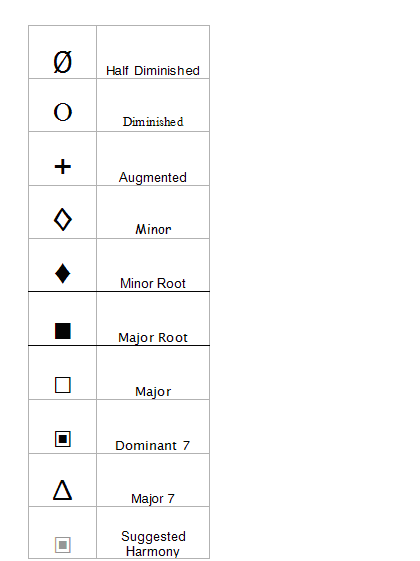Chords
Chords
There is a wealth of information that can be gained from looking at a completed chart. Here is the full list of symbols that are available for use in a chart:

Full Chord Chart
These chord symbols follow standard notation as far as possible.
Here is a chart showing a typical pattern of some slightly more exotic chords.
[seeChordViewer src=”/content/Application/Chords/different chords-viewer”]
Here we can see the use of dominant 7th chords on the E and the B. We can also see that the key of the piece is A minor as the minor symbol appears on the A line which is bordered above and below. For more information on more advanced chords such as the dominant 7th or the diminished 7th chords, click on the links.
Extra information can also be read from the “chord row”. Here we find any alterations and extensions to the symbol shown.
The chord row displays the chord name that is being represented in the chart. This is the place that extra information regarding the specific chord can be displayed. For example a chord that is displayed in the G row may use the symbol for G major, but in the chord row, the extensions and alterations can be listed. Here is a list of the chord types available (from Wikipedia)
| Chord name | Chord symbol | |||
|---|---|---|---|---|
| Major 7th | CMaj7, CMA7, CM7, CΔ7, Cj7, C+7 | |||
| Dominant 7th | C7, C7, Cdom7 | |||
| Minor 7th | Cm7, C−7, C−7 | |||
| Diminished 7th | Co7, Cdim7 | |||
| Half diminished 7th | Cø7, Cm7♭5, C-7(♭5) | |||
| Augmented 7th | C+7, C7+, C7+5, C7♯5 | |||
| Minor major 7th | Cm(Maj7), C−(j7), Cm♯7, C−Δ7, C−maj7 | |||
Further chord extensions such as +9, 11, 13 and 15 can also be displayed in the chord row. As these extensions rarely change the nature of the harmony, there is rarely a reason to display them in the chart itself. Sometimes though, these extensions can change the nature of a chord so that the root becomes ambiguous. Follow the link for a more extensive look at these chords.
The following example shows some chords that have two possible alternatives:
[seeChordViewer src=”/content/Application/Chords/alt chords-viewer”]
This fairly complex example shows some extensions (F9, gm6 etc.) and some alternative chords (gm6-ehalf-diminished, Cb5-F#b5). You can also see the grey chord symbols in the chart and the grey connectors. This shows that there is more than one possible interpretation of the chords a those points. It is often possible by looking at a SeeChord chart to find out which alternative makes most musical sense. Sometimes it is simply a case of joining up the symbols with the simplest line.